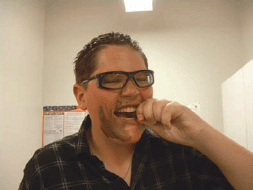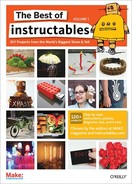Measure the Speed of Light with Chocolate!
A delicious way to enjoy scientific constants

Figure A: What you'll need: chocolate and a way to measure it
In this Instructable, inspired by the book How to Fossilize Your Hamster And Other Amazing Experiments for the Armchair Scientist, we use a bar of chocolate to measure the speed of light.
What you’ll need:
![]() A bar of chocolate
A bar of chocolate
![]() A microwave
A microwave
![]() A metric ruler
A metric ruler
![]() Safety glasses (not that this is dangerous, it just adds awesome-factor to any experiment)
Safety glasses (not that this is dangerous, it just adds awesome-factor to any experiment)
1. Eat some chocolate
You know you want to.
2. To the microwave!!!
Remove the rotating tray thingy from your oven—we don’t want the chocolate to cook evenly.
3. Zap the chocolate
Turn on the microwave until pools of chocolate start to form (about 40 seconds). Don’t overcook itburnt chocolate doesn’t smell so good.
4. Measure
From “hot spot” to “hot spot” (where the chocolate has started to melt). Write down the measurement.
5. Now for the mathy stuff
Ok, now that we know the distance between hot spots, we’ll use some math to figure out the speed of light. First, the distance we measured represents the half-wavelength of the waves being emitted by the microwave. To find the wavelength of the microwaves, we multiply by two. In my example, that gives us a wavelength of:

Figure B: Let the munching begin!
7.628 cm * 2 = 15.256 cm
Since the speed of light is equal to the wavelength times the frequency, we can figure out the speed of light. But we don’t know the frequency of the microwaves. Most microwaves operate at 2.45 GHz, or 2,450,000,000 Hz, so, we take the product of the wavelength and the frequency:
15.256 cm * 2,450,000,000 Hz =
37,377,200,000 cm/s
which, given that we are doing this in a kitchen (and a small error in our measurements are multiplied by 4,900,000,000), is shockingly close to the actual speed of light, which is 29,979,245,800 cm/s, or as it is typically defined, 299,792,458 meters per second.
Figure C: Remove the rotating platter from the oven

Figure D: Measure “hot spot” to “hot spot”
6. Iterate
All good scientists know that repeating an experiment is good for making sure your results are statistically relevant, so do it again. Eat more chocolate. Have Fun!
User Notes
Patrik says: Interesting idea! Of course, you're not going to get a nice linear standing wave inside a microwave oven, so depending on where you place the chocolate you might get a different distance. But it should be in the right order of magnitude at least.
Bradley responds: Sure. This isn’t exactly a super scientific experiment, but if you perform it enough times…
Mike Dillemuth weighs in with: You’re actually measuring the wavelength, or of the cycle of the microwave’s tuned pattern of dispersion, not “the speed of light”…186,000MPS (miles per second). To do that, the photons, which is what light is essentially, would have to make a pattern. Visible light however will NOT. It merely stops. Infrared will make a heat pattern bloom, but then the pattern simply melts the chocolate, as the infrared is pretty hard to focus on one spot running lengthwise to make it “skip” until the waves show themselves as a cyclical/oscillating wave pattern.
Bradley responds: This is true. This was not intended to be an accurate measurement of anything, just a simple experiment that someone in (I dunno…) 6th grade could do easily, to start gaining some understanding of waves, light, etc. I know enough theory to know that we’re not actually measuring the speed of light. But it’s an interesting educational exercise nonetheless, and that was my intent in publishing this Instructable.
In response to some confusion over the term “speed of light,” Harry Collard offers: All electromagnetic waves, (in order: Radio, Microwaves, Infrared (heat), Visible Light, Ultra Violet, X-Ray, and Gamma) travel at the “speed of light.” The name is misinterpreted. “The speed of light” is actually the speed that electromagnetic waves travel, and visible light just happens to be part of this spectrum.
Bradley Powers is an engineering student attending the Franklin W. Olin College of Engineering (Class of 2010) studying robotics. He is a former Instructables intern, and in his free time, can be found building robot helicopters and wielding the latest safety eyewear styles.

